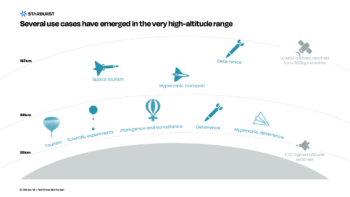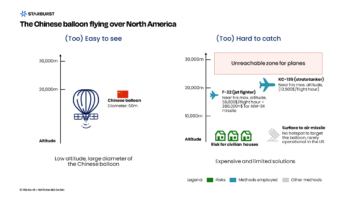Soon to be detected but not easily intercepted: how high-altitude balloons highlight the challenges and opportunities of the 20-50km range

The ambition of the French forces to improve surveillance of Higher Airspace Operations (HAO) in the recently voted Act on Military Programming (LPM) re-demonstrates the importance of high altitude in the upcoming years. Above 18 km, where national sovereignty no longer applies and below the Karman line, the high-altitude range has become a strategic layer where all types of devices can be sent, from the most basic to the most sophisticated. Yet, if surveillance is a mandatory step to enable a permanent protective posture, a quick and affordable response is still to be found to assert sovereignty in higher airspace.
The use and occupation of the HAO is increasing, and a regulatory framework is still to be defined. Activity in the higher airspace has been increasing for the last years, with a multiplication of use cases (see the illustration below). In France, emerging actors including Zephalto, which plans a civil project to send tourists in the high altitude by 2024 through a balloon, are good examples of the opening of this segment of the sky, so far mostly reserved to institutional players. Emerging actors, though, are not alone: major projects from established companies are on the way. A case in point is the Google Loon project, now abandoned, which aimed at launching 3000 balloons to deploy internet in regions with poor infrastructure. Constellations of balloons can indeed constitute an alternative to satellites on a one-off basis, to perform tasks such as providing images of the earth or infrastructures. Finally, French major projects using the HAO, like Airbus’ Zephyr or Thales’ Stratobus are worth citing too.
High altitude is, in fact, particularly interesting because it is less expensive to reach than space and devices can be equipped with cost-reduced technologies that deliver great performance, such as sensors, high-resolution micro-cameras, radars and small engines. Among the potential use cases are also hypersonic systems and spying balloons, which caught our attention as they highlighted the urge for countries to develop solutions monitoring the new boundaries of the sky.
As of today, these technologies and projects have one thing in common: they are all evolving within a vague and permissive legislative framework. In fact, the only constraints truly faced by companies like Zephalto[1] are when crossing the controlled airspace. However, discussions about stricter rules for the HAO are ongoing, following raising concerns for sovereignty. Hemeria, which is working with the French governmental agency DGA (Direction Générale de l’Armement) to introduce a manoeuvring balloon for military purposes, is sparking conversations around regulatory frameworks. Better regulating the HAO was also at the heart of the 2023 French Air and Space Force seminar. Yet, these initiatives not unanimous: some worry that they will slow down progress in the field.

Use cases according to their respective expected altitudes – Starburst
This “legal loophole” forces countries to develop new means for surveillance.
In fact, at such altitude, not only are flying devices further away from Earth; but they also tend to be stealthier. This is especially true for balloons, as they are made of little metal structure, lack sharp edges, and often have no engines. Yet, their payload, which often sends waves to communicate, can make them easier to detect. Additionally, radars like the AN/FPS-117 used for NORAD detect aircrafts as high as 30 km – and space surveillance systems do even better: French system GRAVES monitors satellites from 400 km and up to 1000km of height. As a result, although detecting balloons is not a straightforward process, it remains do-able, even more so with new space situational awareness solutions and technologies that are developed every day. Detection will therefore not remain an issue for long.
High expenditure for a low (and cheap) threat
However, another issue was emphasized by the Chinese balloon flying over America: finding a quick and affordable response to high altitude threats. As a reminder, the balloon was shot down after 8 days above North America by a F-22. It fired a missile at an altitude of 18km and struck the balloon less than 2km above. Below are the costs for this military intervention:
- the AIM-9X missile cost more than 380,000$
- operating costs for the surveillance and intervention of USAF aircrafts, including F-22s, U-2s, E-3Bs, KC-10As, KC-135Rs and RC-135s) exceed $3,500,000
- the total bill for the US forces exceeds $4,000,000
Disproportionate, considering that balloons constitute a cheaper technology:
- the envelope, the gas inside and the implementation of the flight are worth a few tens of thousands of euros for small balloons and a few hundreds of thousands of euros for very large ones
- as a result, the cost of the balloon mostly depends on the cost of the payload
- However, helium (the most widely used gas for balloons) prices have steadily increased in the last 20 years and are expected to continue to grow. In 2022, helium prices hovered around 30€/m3 to 50€/m3, depending on the quantity bought. Other alternative, such as H2, becomes widespread, leading soon to more cost-effective solutions, especially for attacking balloons.
- For now, despite increasing helium prices, balloons remain a cheaper alternative to satellites, which sells earth images at the price of 100€/km², with a minimal purchase of 100km² of images
Too expensive to shoot down balloons, fighter jets also lack technological capacities. The Chinese balloon was flying abnormally low and if it had been higher, fighter jets would not have been able to reach it (see the illustration below). Other possible technologies to shoot it down included surface-to-air missile systems, but they are often not operational in western countries and balloons lack of hotspots to target them. In addition, shooting down the balloon, regardless of how it is executed, is risky: balloon debris and fired ammunition jeopardize civilians below. In 1998, when a balloon was identified as a threat over Canada, a CF-18 fired more than a thousand bullets at it. This intervention was not fully satisfactory as the balloon took 6 days to go down.
Finally, it is important to note that the Chinese balloon was flying by itself. Had there been more balloons, the intervention would have been even more complicated. In fact, since balloon costs are, when excluding the payload, very cheap, a malicious saturation of the HAO through a swarm of spying balloon must be anticipated, all the more so since swarms offer a better image persistence. For instance, it is possible to imagine dozens of balloons flying in the sky, with only a few of them actually spying on the country below. In that case, the question of the intervention is very tricky. Shooting every balloon is deeply complicated, considering the risks and costs of shooting just one balloon, but identifying the problematic balloons is not straightforward. As a result, means to regulate high altitude aircrafts are very limited and costly, and new technological solutions are needed.

Perspective on the interception challenges posed by the “Chinese balloon” flyover – Starburst
Lack of appropriate solutions creates opportunities for defence players
Finding the right way to response to these threats is technologically challenging. Reactivity is key, with always-on systems ready to intercept and neutralize targets, without endangering citizens on the ground. But reactivity comes at a cost, and low-cost threats will multiply. What are the options?
Space-based technologies to attack balloons in high altitude are not mature enough and do not offer an advantage in terms of robustness, responsiveness, and price efficiency. Using capture satellites (developed for debris removal) is impossible at this altitude. Even at higher altitude, non-collaborative capture solutions face major technological barriers: sustained propulsion, resistance to disintegration, autonomous non collaborative rendezvous and safe capture. The US DARPA is also working on laser technologies from space, but at very early stage. Neutralization is not going to come from space.
From Earth, today’s early trends on HAO show similarity with current UAVs (in lower altitude) use cases:
- Basic technologies have increasingly been used for both civilian (personal use and entertainment) and military (loitering munitions) cases, and they represent the majority of uses. For HAO, this would correspond to all the balloons launched, whether they are for tourism, for military ISR or weather studies.
- Very sophisticated UAVs have also emerged for military purposes, but they remain marginal (such as the MQ-25 Stingray) They can fly high, for a long time and withstand bad weather conditions. They perform ISR or launch bombs, and they come at a very expensive cost: a few dozen million dollars each, and up to 200M$. Hypersonic missiles, which would be used in the high-altitude portion, should have similar range of costs and be as sophisticated. It’s also worth noting that the issue of swarms is as present for UAVs than it is for balloons. As a result, HAO create similar type of issues than UAVs.
For simple UAVs that fly over sensitive zones (public gatherings, military bases…), anti-drone guns have been proven efficient, sending electromagnetic waves to shut down the UAV and forcing them landing. These systems, now widely used, could be adapted, and deployed on balloons to neutralize potential threats in high altitude. For sophisticated UAVs that have a true intent to harm, however, solutions have yet to be developed, and current incidents are handled on a case-by-case basis. Just like for UAVs, high altitude solutions against sophisticated threats will require compromises, balancing risks and costs.
The technological roadmap associated with HAO challenges consequently emerges in two stages:
- Technological adaptation of jammers on balloons will allow the air forces to control most high-altitude threats. These adaptations could come rapidly: balloons are already cheap, quick to deploy and can reach the stratosphere within 30 minutes (considering a climbing speed of 5m/s). They can also swiftly be transported in containers by ground forces. One of the challenges remaining, however, is to successfully guide the balloon to its target. To do so, a step-by-step climb, to take advantages of the winds, is used, but it necessitates a high computational capacity. Stratolia, a French start-up who plans to send balloons for earth observation purposes, work on these types of algorithms and aims at predicting a balloon trajectory to within 3km. It is looking to offer these trajectory calculation services to other actors in the balloon ecosystem.
- To tackle more sophisticated threats, like swarms of balloons or super/hypersonic objects, it will take longer development time and be more challenging, as it will necessarily involve advanced technologies. Experimental hypersonic aircrafts like the X-43 can give an idea of what these technologies could look (and cost) like.
The 20,000-50,000 m segment, whose use is growing, introduces new problems of safety and sovereignty. Governments have set themselves the objective of improving their surveillance capacity in the short term. However, the Chinese incident over North America showed that response capacities are also lacking: even in an easy case, the intervention was very costly and tricky. Governments are hence expected to go one step further surveillance and, through their defence procurement agency, draw up a set of specifications for a low-cost solution to neutralize balloons. Therefore, the opportunity belongs to industrials to develop a roadmap tailored to HAO challenges, relying first on existing technologies, to reduce costs and shorten development time. The increase in threats at this altitude means that private and public players need to react quickly and find appropriate solutions. Surveillance is just the first step in a larger roadmap.
We would particularly like to thank Zephalto for their contribution to this article, through their willingness to exchange ideas and their time to carefully review this paper.
[1] Since Zephalto will operate civil manned flights, the company plans to follow the rules of the civil aviation even when above the controlled airspace, although it currently has no obligation to do so.

